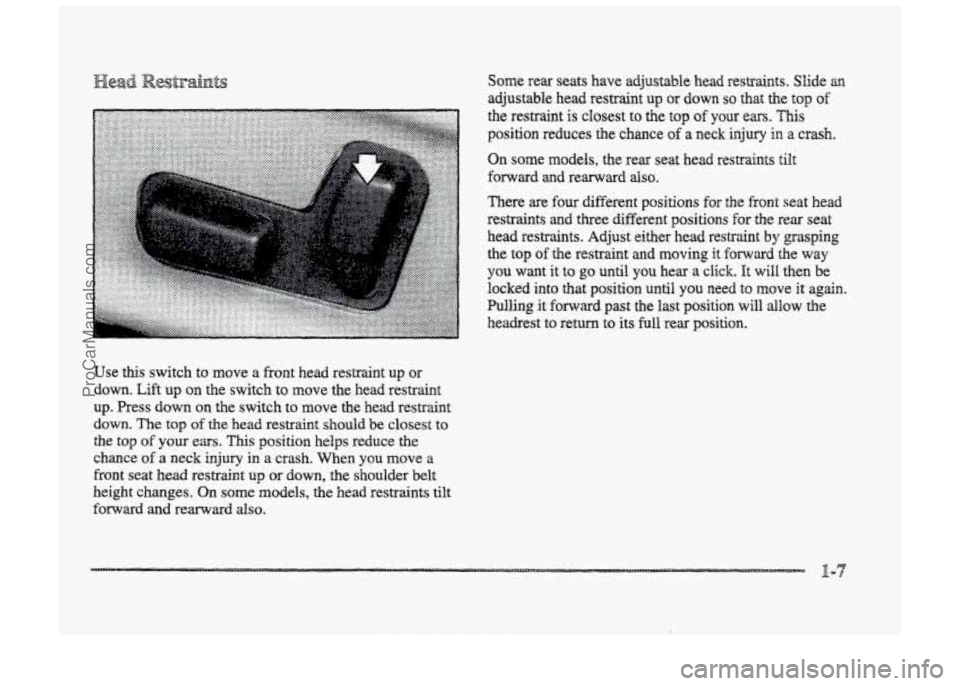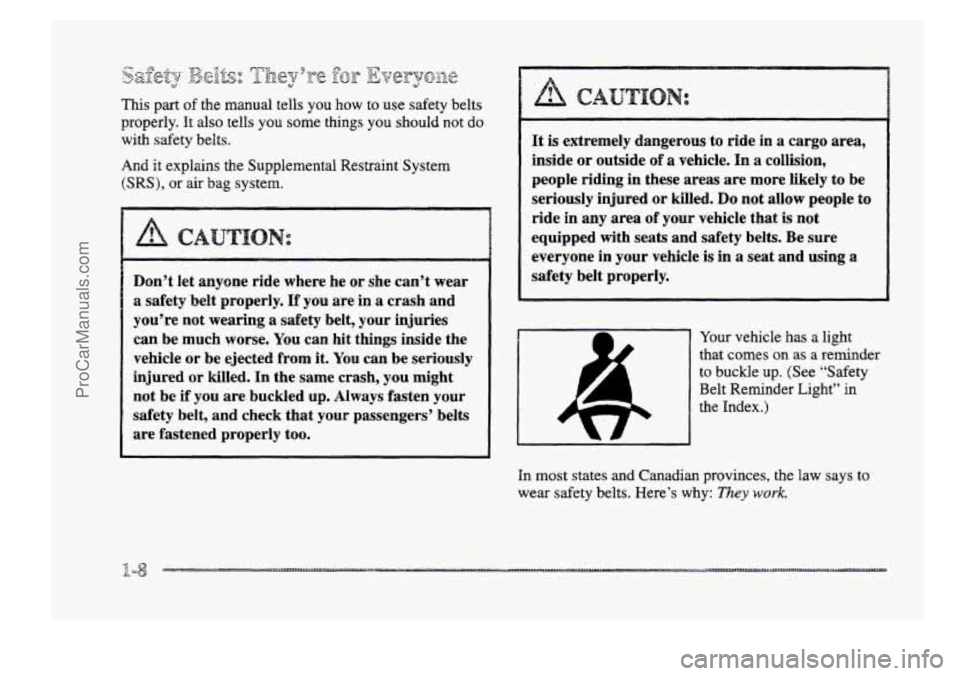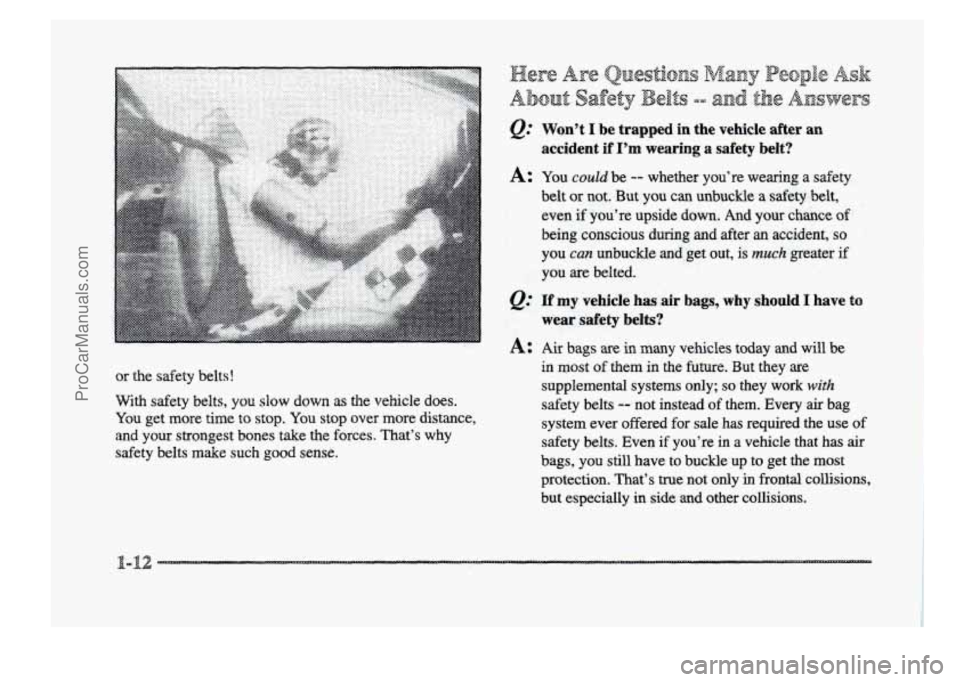Page 13 of 426
Here you'll find information about the seats in ycur Buick and how to use your safety belts propedy. You can also
learn about some things you should not do with air bags and safety belts.
1-2
1-8
1-12
1-13
1-13
1-20
1-21
1-28
B -27 Seats
and Seat Controls
Safety
Belts: They're for Everyone
Were
Are Questions Many Teogle Ask
About Safety Belts -- and the Answers
How to Wear Safety Belts Properly
Driver Position
Safety Beit Use During Pregnancy
Right
Front Passenger Position
Supplenental Restraint System
(SRS)
Center Passenger Position
1-28
1-32
1-34
1-37
1-47
9 -50
i -50
1-50
Rear Seat Passengers
Rear Safety Belt
CSITI€OI-~ Guides for
Children
and Small Adults
Children
Child Restraints
Larger Children
Safety Belt Extender
Checking Your
Restraint Systems
Replacing Restraint System
Parts After
a Crash
ProCarManuals.com
Page 15 of 426
I
8 Raise or Bower the entire seat cushion by holding the
whole
horizonhl control up or down.
@ hsh the vertical control forward to bring the seat to
a more upright position. Push it rearward to recline
the seatback.
Raise
or lower the shoulder belt aamd head rest by
pushing the vertical contro1 to the top or bottom.
You can use this memory €unction to save your seat
cushion (mintas the head restraint), optional lumbar,
mirror adjustment, window lockout, HVAc and radio
settings by using the foltlowing procedure:
1. You must first program the SEAT RECALL feature
to be
ON when this choice appears on the DHC.
See “Memory Seat Recall” in the hdex fop
programming instructions.
ProCarManuals.com
Page 19 of 426

Use this switch to move a front head restraint up or
down.
Lift up on the switch to move the head restraint
up. Press down on the switch to move the
%led restraint
down. The top of the head restraint should be closest to
the top of
your ears. This position helps reduce the
chance
of a neck injury in a crash. When you move a
Eront seat head restraint up or down, the shoulder belt
height changes. On some models, the head restraints tilt
forward and rearward also.
Some rear seats have adjustable head restraints. Slide an
adjustable head restraint up or down so that the top of
the restraint is closest to the top of your ears. "his
position reduces the chace of a neck injury in a crash.
On some models, the rear seat head restraints tilt
f~r~ad md rearward dso.
There are four different p~sitions for the front seat head
restraints
and three different positions for elme rear seat
head restraints. Adjust either head
restsaint by grasping
the top
of the restraint and moving it f~l7;~lmd the way
you want it to go until YOU hear a click. It will then be
locked into that position until you need to move it again.
Pulling it
forward past the last position will allow the
headrest to return
to its full rear position.
ProCarManuals.com
Page 20 of 426

This part of the manual tells you how to use safety belts
properly. It also tells you some things you should not do
with safety beits.
And it explains the Supplemental Restraint System
(SRS), or air bag system.
~ ~ ~~~~
Don’t let anyone ride where he or she can’t wear
a safety belt properly. If you are in a crash and
you’re not wearing a safety belt, your injuries
can be much worse. You can hit things inside the
vehicle or be ejected from
it. You can be seriously
injured
or killed. In the same crash, you might
not be if you are buckled up. Always fasten your
safety belt, and check that your passengers’ belts
are fastened properly too.
i
i
1
~
It is extremely dangerous to side in a cargo area,
people riding in these areas
are more likely to be
seriously injured or killed.
Do not allow people to
ride in any area of your vehicle that is not
equipped with seats and safety belts. Be sure
everyone in your vehicle
is in a seat and using a
safety belt properly.
I inside or outside of a vehicle. In a collision,
..r Your vehicle has a light
that
comes on as a reminder
to buckle up. (See “Safety
Belt Reminder Light” in
the Index.)
In most states
and Canadian provinces, the law says to
wear safety belts. Here’s why:
They work.
ProCarManuals.com
Page 21 of 426
You never know if you'll be in a crash. If yo3 do have
a crash, you don't know if it will be a bad oDe.
A few crashes are mild, and some crashes can be so
serious that even buckled up a person wouldn't survive.
But most crashes are in between. In many of them,
people who buckle up can survive and sometimes
walk away. Without belts they could have been badly
hurt or killed.
After more than 30 years of safety belts in vehicles,
the facts are clear. In most crashes buckling up does
matter ... a lot!
..... .............................. :.:::::;:.:.::::.:.:.:-:: .................... ................................................ _..: ..... .*.....-
Fake the simplest vehicle. Suppose It's just a seat
on wheels.
ProCarManuals.com
Page 24 of 426

or the safety belts!
With safety belts, you slow down as the vehicle does.
You get more time to stop. You stop over more distance,
and
your strongest bones take the forces. That’s why
safety belts make such
good sense.
Q: Won’t 1 be trapped in the vehicle after an
accident if I’m wearing a safety belt?
A: You could be -- whether you’re wearing a safety
belt
or not. -But you can unbuckle a sdety belt,
even if you’re upside.down. And your chance of
being conscious during and after an accident, so
you cun unbuckle and get out, is much greater if
you
are belted.
@’ If my vehicle has air bags, why should I have to
A: Air bags are in many vehicles today and will be
in most
of them in the future. But they are
supplemental systems
only; so they work with
safety belts -- not instead of them. Every air bag
system ever offered for
sale has required the use of
safety belts. Even if you’re in a vehicle that has air
bags, you still have to buckle up to get the most
protection. That’s
true not only in frontal collisions,
but especially in
side and other collisions.
wear safety belts?
ProCarManuals.com
Page 25 of 426
@ If I’m a good driver, and I never drive €as from
home, why should
I wear safety belts?
A t YQU may be an excellent driver, but if you’re in an
accident
-- even one that isn’t your fault -- you and
your passengers can be hurt. Being a good driver
doesn’t protect you from things beyond your
control,
such as bad drivers.
Most accidents occur within
25 miles (40 h> of
home.
And the greatest number of serious injuries
and deaths occur at speeds of less than 40 mph
(65 krm/h).
Safety belts are for everyone. First,
you’ll want to know which restraint systorris your
vehicle has.
We’ll start
with the driver position.
This
part describes the driver’s restraint system.
ProCarManuals.com
Page 26 of 426
The driver has a lap-shoulder belt. Here’s how to wear
it properly.
1. Close and lock the door.
2. Adjust the seat (to see how, see “Seats” in the Index)
so you can sit up straight.
3. Pick up the Batch plate and pull the belt across you.
Don’t let it get twisted.
4. Push the latch plate into the buckle until it clicks.
Pull up on the latch plate to make sure it is secure.
E
the belt isn’t long enough, see “Safety Belt
Extender” at the end. of
this section.
Make sure the release
button on the buckle is
positioned so you would be able to unbuckle the
‘safety belt quickly i€ you ever had to.
ProCarManuals.com